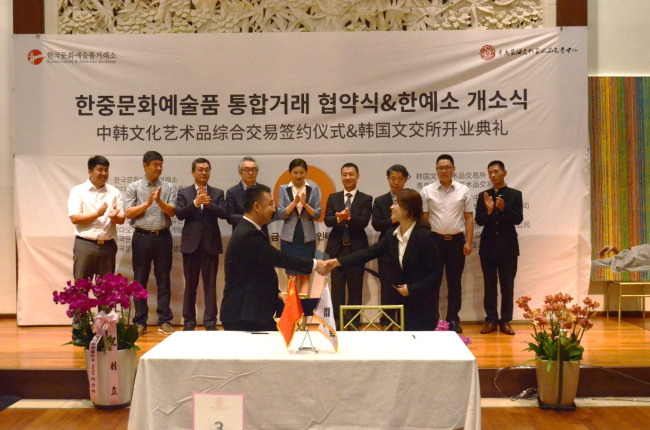Chinese art trading scheme enters Korea
Will the alternative art investment bring sound profit, or disrupt art market?
By Lee Woo-youngPublished : June 16, 2016 - 15:47
Artworks are usually purchased primarily for aesthetic reasons and are mostly privately owned, but a relatively new Chinese model of art investment allows multiple buyers to share an artwork.
The Chinese model of artwork stock exchange, which invites investors to buy and sell shares of artworks, has landed in Korea, with the China National Culture and Art Co., LTD, a holding company under the China’s Culture Ministry, opening the Korea Culture and Artworks Exchange on Wednesday. This marks the first international foray of the Chinese model of artwork stock exchange.
Artworks are traded in shares on the Korean artwork trading platform. Investors can buy and sell shares of artworks, stamps, banknotes and also invest in other cultural content such as movie and TV drama projects. Only artworks valued at 100 million won ($85,506) and above can be listed.
“Today is a significant day for us, listing Korean and Chinese artworks on the Korea Culture and Artworks Exchange and integrating the trading activities for Korean and Chinese investors,” said Kang Eun-hee, president of the KCAE at the opening ceremony on Wednesday in Seoul.
“The KCAE will cooperate with the Qingdao-based artwork exchange to combine listed artworks and fix problems associated with dealings of artworks and cultural content, and move forward to fair sales of cultural content,” she said.
The China National Culture and Art Co., LTD runs two artwork stock exchanges in China, including the Beijing-based Culture and Artwork Exchange and Qingdao-based Culture and Artwork Exchange. The new concept of trading shares in cultural items began in China in 2009 with the opening of the Shanghai Culture Asset and Equity Exchange on June 15, 2009, according to Beijing Review. Since then, some 20 artwork exchanges have sprouted in China.
The Chinese model of artwork stock exchange, which invites investors to buy and sell shares of artworks, has landed in Korea, with the China National Culture and Art Co., LTD, a holding company under the China’s Culture Ministry, opening the Korea Culture and Artworks Exchange on Wednesday. This marks the first international foray of the Chinese model of artwork stock exchange.
Artworks are traded in shares on the Korean artwork trading platform. Investors can buy and sell shares of artworks, stamps, banknotes and also invest in other cultural content such as movie and TV drama projects. Only artworks valued at 100 million won ($85,506) and above can be listed.
“Today is a significant day for us, listing Korean and Chinese artworks on the Korea Culture and Artworks Exchange and integrating the trading activities for Korean and Chinese investors,” said Kang Eun-hee, president of the KCAE at the opening ceremony on Wednesday in Seoul.
“The KCAE will cooperate with the Qingdao-based artwork exchange to combine listed artworks and fix problems associated with dealings of artworks and cultural content, and move forward to fair sales of cultural content,” she said.
The China National Culture and Art Co., LTD runs two artwork stock exchanges in China, including the Beijing-based Culture and Artwork Exchange and Qingdao-based Culture and Artwork Exchange. The new concept of trading shares in cultural items began in China in 2009 with the opening of the Shanghai Culture Asset and Equity Exchange on June 15, 2009, according to Beijing Review. Since then, some 20 artwork exchanges have sprouted in China.

Kang Chan-young, vice chairman of the China National Culture and Art Co., LTD, said the Beijing artwork stock exchange, which opened in November 2015, reports an average daily trading volume of 30 billion won for stamps and banknotes. The Qingdao artwork stock exchange, which opened in March this year, engages in trading shares of stamps, banknotes, cultural content and Puer tea. Its daily trading volume exceeds 10 billion won.
“The artwork exchanges integrate art and finance,” said Sun Xiaoliang, head of the Qingdao artwork stock exchange.
The KCAE will work with the Korean Fine Arts Association in evaluating artworks to be listed in the exchange market. Artworks listed will be divided into shares. For example, an artwork valued at 100 million won can be divided into 100 million shares at 10 cents apiece.
Experts, however, are wary of the concept of artworks being traded in shares, noting that it may create a bubble in the art market.
In 2011, two Chinese paintings listed on the Tianjin Cultural Artwork Exchange saw their shares soar by 18 times in the two months after its initial listing, leading Chinese regulators to suspend trading for five days, according to China Daily.
There have been many reported cases of excessive increases in the price of artworks, which led the Chinese government to amend artwork stock exchange rules, according to an economics professor who has long been studying the global art market and who has tracked the Chinese model of artwork stock exchange for two to three years.
“It is an alternative art market, in addition to the primary market of setting the price for the artwork at galleries and exhibitions and the secondary market of art auctions. It’s too early to evaluate the Korean artwork exchange as it is just starting,” he said on condition of anonymity.
“(In order to prevent damage), investors should look into the artists, their reputation in the art world and reviews of their works before deciding to invest,” he added.
The head of an auction house in Seoul also stressed the need for caution.
“You can’t expect prices of every artwork to increase. It depends on so many factors. Only good works go up, not every work,” he said on condition of anonymity.
By Lee Woo-young (wylee@heraldcorp.com)
















![[KH Explains] Hyundai's full hybrid edge to pay off amid slow transition to pure EVs](http://res.heraldm.com/phpwas/restmb_idxmake.php?idx=652&simg=/content/image/2024/04/18/20240418050645_0.jpg&u=20240419100350)

